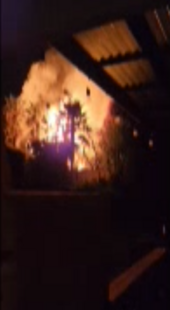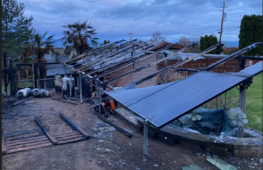Glad no one was hurt or killed. Win and Win. Op lives in Belgium and had insurance according earlier post. 3 phase Victron 5000 setup to charge Tesla. System died at night with basically no loads is what read. Nothing going on.
In the past there was a Victron Fuse shown on youtube smoking - was a year or so ago… at around that same time ppl were saying there were counterfeit branded Victron mega fuses on the internet being sold for that video. Video is gone.
Victron mega fuse are shown as slow blow…. In video below….. Hmmmm Again I can’t find the video of the mega fuse doing an arc smoke show. I Found one not blowing until 2x amps wish he had shown timer.
Hmmm slow blow

community.victronenergy.com
Multi-Plus II solder bridge at battery terminals in link. Not sure if this developed or if it was out of box new. Details Reported his fuse blew and saved system. Hmmm hair solder bridge at inverter blew the Victron fuse…… must have been one strong hair of solder.

community.victronenergy.com
One could argue if OP had stayed with only 6 strings might not been any problems. Pushing until something pushes back…..
We always want more and more. Right?
Have questionS what was the shunt rating for this system? Was the shunt upgraded? Was there a shunt?
Obviously Something caused the fuse to fry. Something kicked it off to domino on a system that was assembled 4-5 years ago with follow up battery changes.
But the other 6 strings now see that shorted battery string as a load.
The voltage may start an arc but the current will maintain it over a longer distance. Look for a youtube video where someone is laying a screwdriver across a 12v car battery. He never actually touches the other post and then he draws the arc out what looks like 4 to 6 inches.
As the fuse blows there is a very small gap and the arc starts. As the fuse element draws back and melt the arc extinguishes under normal curcumstances. With high current even a low voltage can keep that arc going.
The class T has what appears to be sand in it that fills in the gaps when the fuse elements burn away. So now the arc has to blow through the sand to keep going. Just a theory but it may even fuse some of that sand material into glass.
If anyone has blown class t fuses around would be interesting to sift and see what is left?
We use to cut the Various T class type fuses apart and inspect them when components failed on locomotives - r&d. Bussmann makes good fuses. The sand turns to glass. Sometimes they still carry voltage - no current. Megger finds them but meter ohm scale might show as good. If fuses are in parallel we always replaced both by practice because other one was stressed - tattle tales pop on some fuses but not on others. Molten copper combination with shape charge defeats armor. The sand arrest the molten copper - snuffs fire. Shut off boxes sometimes blow if something on load is shorted the copper from contacts cuts right through the box front…why you stand to side cutting shut off box in ….on.
Exactly which fuse blew in this setup? Read he had correct amp Victron recommended fuses on batteries Victron correct amp recommended fuses on inverters. Which fuse blew?
These Victron 58v fuses are probably slow blow because Victron inverters can usually do 3x rated load for x amount of time. Right? Advantage of lf….
Been nice if guy in video had keep timer running he took 100amp mega fuse to ~230 amp.


I highly doubt this will ever be solved. If the components were not considered the best then would have already been dead and blamed on cheap inverter or something else.
Just by chance what was the shunt rated at in this system? Undersize shunts turn into heating elements until burn up.
I find it odd that Victron wants 6 awg on “ac out” with their 3000 multiplus II inverter. Hmmmm on 5000 the “ac in” is smaller than the “ac out.”
Since this guy was in Belgium assume he was using the 230vac models?










